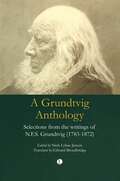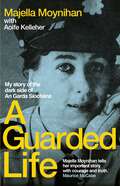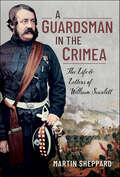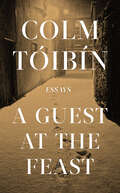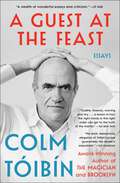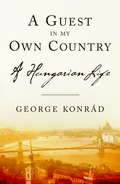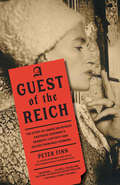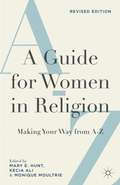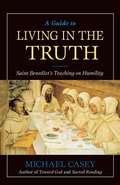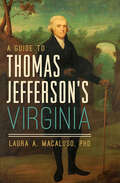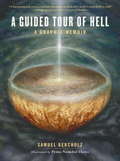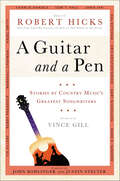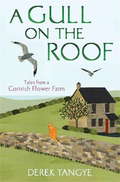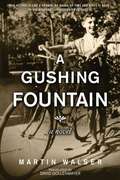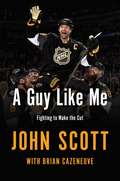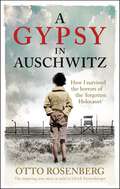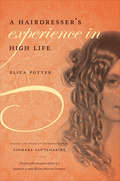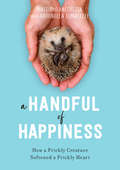- Table View
- List View
A Grundtvig Anthology: Selections from the writings of N.F.S. Grundtvig (1783-1872)
by Niels Lyhne JensenA notable figure in the cultural and social history of Denmark, Nikolaj Frederik Severin Grundtvig's (1783-1872) works are still salient for us now. Highlighting his vivacious ideas and personality, A Grundtvig Anthology includes extracts from Grundtvig's historical, educational, theological, devotional, and poetical works. Each chapter is prefaced by insightful explanatory introductions by leading authorities on Grundtvig's monumental body of work, along with a comprehensive general introduction and illuminating annotations. Grundtvig viewed the myths of the North as an expression of the moral values and understanding of life, and his hymn and song writing reveal the same joy of life, openness and freedom as the Norse perspective. By offering selections from across his major works, this anthology succeeds in capturing his spirit in English translation, and continuing his written legacy.
A Guarded Life: My story of the dark side of An Garda Síochána
by Majella MoynihanA GARDA, A FORCED ADOPTION, A FIGHT FOR JUSTICEIn 1984, Majella Moynihan was a fresh-faced young garda recruit when she gave birth to a baby boy. Charged with breaching An Garda Síochána's disciplinary rules - for having premarital sex with another guard, becoming pregnant, and having a child - she was pressured to give up her baby for adoption, or face dismissal. It forced her into a decision that would have devastating impacts on her life. Majella left the force in 1998 after many difficult years and, in 2019, following an RTÉ documentary on her case, she received an apology from the Garda Commissioner and Minister for Justice for the ordeal she endured as a young garda. Here, for the first time, she tells the full story. From an institutional childhood after the death of her mother when she was a baby, to realising her vocation of becoming a guard only to confront the reality of a police culture steeped in misogyny and prejudice, A Guarded Life is both a courageous personal account of hope and resilience in the darkest times, and a striking reflection on womanhood and autonomy in modern Ireland.
A Guarded Life: My story of the dark side of An Garda Síochána
by Majella MoynihanA GARDA, A FORCED ADOPTION, A FIGHT FOR JUSTICEIn 1984, Majella Moynihan was a fresh-faced young garda recruit when she gave birth to a baby boy. Charged with breaching An Garda Síochána's disciplinary rules - for having premarital sex with another guard, becoming pregnant, and having a child - she was pressured to give up her baby for adoption, or face dismissal. It forced her into a decision that would have devastating impacts on her life. Majella left the force in 1998 after many difficult years and, in 2019, following an RTÉ documentary on her case, she received an apology from the Garda Commissioner and Minister for Justice for the ordeal she endured as a young garda. Here, for the first time, she tells the full story. From an institutional childhood after the death of her mother when she was a baby, to realising her vocation of becoming a guard only to confront the reality of a police culture steeped in misogyny and prejudice, A Guarded Life is both a courageous personal account of hope and resilience in the darkest times, and a striking reflection on womanhood and autonomy in modern Ireland.
A Guarded Life: My story of the dark side of An Garda Síochána
by Majella MoynihanA GARDA, A FORCED ADOPTION, A FIGHT FOR JUSTICEIn 1984, Majella Moynihan was a fresh-faced young garda recruit when she gave birth to a baby boy. Charged with breaching An Garda Síochána's disciplinary rules - for having premarital sex with another guard, becoming pregnant, and having a child - she was pressured to give up her baby for adoption, or face dismissal. It forced her into a decision that would have devastating impacts on her life. Majella left the force in 1998 after many difficult years and, in 2019, following an RTÉ documentary on her case, she received an apology from the Garda Commissioner and Minister for Justice for the ordeal she endured as a young garda. Here, for the first time, she tells the full story. From an institutional childhood after the death of her mother when she was a baby, to realising her vocation of becoming a guard only to confront the reality of a police culture steeped in misogyny and prejudice, A Guarded Life is both a courageous personal account of hope and resilience in the darkest times, and a striking reflection on womanhood and autonomy in modern Ireland.
A Guardsman in the Crimea: The Life & Letters of William Scarlett
by Martin SheppardThe Brigade of Guards was the elite force of the British Army in the Crimea. William Scarlett, a captain in the Scots Fusilier Guard and one of the most active junior officers in the regiment, fought throughout the entire campaign. After the Allied landing at Kalamita Bay, Scarlett rallied his regiment at a critical moment during the battle of the Alma, supported by his company sergeant, who was awarded the VC. William Scarlett’s life may well have been saved after the battle of Balaklava by becoming an aide de camp to his uncle, General James Scarlett, the commander of the Heavy Brigade. This meant that he did not fight at Inkerman, which took a heavy toll on the officers of the Guards Brigade. Returning to the trenches early in 1855, William Scarlett was involved in all the phases of the siege of Sebastopol until its fall in September 1855. The survival of 139 previously unpublished letters record Scarlett’s deeds and thoughts. Written to nineteen different correspondents, and deliberately intended by him to form a personal account of his rôle in the war, his letters provide a forceful commentary on the successes and failures of the British army in the East. His life before and after the war is well recorded. Becoming the third Lord Abinger in 1861, Scarlett was the second English peer to marry an American. He built a castle in Scotland, where Queen Victoria stayed in 1873, and two of his daughters became notable suffragettes.
A Guest at the Feast: Essays
by Colm ToibinFrom bestselling and Booker-nominated author Colm Tóibín comes a beautiful collection of essays ranging from personal memoir to brilliantly acute writing on religion, literature and politics.From the melancholy and amusement within the work of the writer John McGahern to an extraordinary essay on his own cancer diagnosis, Tóibín delineates the bleakness and strangeness of life and also its richness and its complexity. As he reveals the shades of light and dark in a Venice without tourists and the streets of Buenos Aires riddled with disappearances, we find ourselves considering law and religion in Ireland as well as the intricacies of Marilynne Robinson's fiction.The imprint of the written word on the private self, as Tóibín himself remarks, is extraordinarily powerful. In this collection, that power is gloriously alive, illuminating history and literature, politics and power, family and the self.
A Guest at the Feast: Essays
by Colm ToibinNamed a Most Anticipated Book of 2023 by LitHub and The Millions! From one of the most engaging and brilliant writers of our time comes a &“not to be missed&” (LitHub) collection of eleven essays about growing up in Ireland during radical change; about cancer, priests, popes, homosexuality, and literature.&“IT ALL STARTED WITH MY BALLS.&” So begins Colm Tóibín&’s fabulously compelling essay, laced with humor, about his diagnosis and treatment for cancer. Tóibín survives, but he has entered, as he says, &“the age of one ball.&” The second essay in this seductive collection is a memoir about growing up in the 1950s and &’60s in the small town of Enniscorthy in County Wexford, the setting for many of Tóibín&’s novels and stories, including Brooklyn, The Blackwater Lightship, and Nora Webster. Tóibín describes his education by priests, several of whom were condemned years later for abuse. He writes about Irish history and literature, and about the long, tragic journey toward legal and social acceptance of homosexuality. In Part Two, Tóibín profiles three complex and vexing popes—John Paul II, Benedict XVI, and Francis. And in Part Three, he writes about a trio of authors who reckon with religion in their fiction. The final essay, &“Alone in Venice,&” is a gorgeous account of Tóibín&’s journey, at the height of the pandemic, to the beloved city where he has set some of his most dazzling scenes. The streets, canals, churches, and museums were empty. He had them to himself, an experience both haunting and exhilarating. &“A tantalizing glimpse into Tóibín&’s full fictional powers,&” (The Sunday Times, London) A Guest at the Feast is both an intimate encounter with a supremely creative artist and a glorious celebration of writing.
A Guest in my Own Country
by George KonradWinner of the 2007 National Jewish Book Award in the category of Biography, Autobiography & MemoirA powerful memoir of war, politics, literature, and family life by one of Europe's leading intellectuals.When George Konrad was a child of eleven, he, his sister, and two cousins managed to flee to Budapest from the Hungarian countryside the day before deportations swept through his home town. Ultimately, they were the only Jewish children of the town to survive the Holocaust.A Guest in My Own Country recalls the life of one of Eastern Europe's most accomplished modern writers, beginning with his survival during the final months of the war. Konrad captures the dangers, the hopes, the betrayals and courageous acts of the period through a series of carefully chosen episodes that occasionally border on the surreal (as when a dead German soldier begins to speak, attempting to justify his actions).The end of the war launches the young man on a remarkable career in letters and politics. Offering lively descriptions of both his private and public life in Budapest, New York, and Berlin, Konrad reflects insightfully on his role in the Hungarian Uprising, the notion of "internal emigration" - the fate of many writers who, like Konrad, refused to leave the Eastern Bloc under socialism - and other complexities of European identity. To read A Guest in My Own Country is to experience the recent history of East-Central Europe from the inside.
A Guest of the Reich: The Story of American Heiress Gertrude Legendre's Dramatic Captivity and Escape from Nazi Germany
by Peter Finn“I read A Guest of the Reich breathlessly, and found myself amazed by the pluck, guts, and courage of Gertrude Legendre.” —Lisa Birnbach, author of True Prep “Thrilling!” —Bill Dedman, author of Empty Mansions The dramatic story of a South Carolina heiress who joined the OSS and became the first American woman in uniform taken prisoner on the Western front—until her escape from Nazi Germany. Gertrude “Gertie” Legendre was a big-game hunter from a wealthy industrial family who lived a charmed life in Jazz Age America. Her adventurous spirit made her the inspiration for the Broadway play Holiday, which became a film starring Katharine Hepburn. When the Japanese attacked Pearl Harbor, Legendre, by then married and a mother of two, joined the OSS, the wartime spy organization that preceded the CIA. First in Washington and then in London, some of the most closely-held United States government secrets passed through her hands. In A Guest of the Reich, Peter Finn tells the gripping story of how in 1944, while on leave in liberated Paris, Legendre was captured by the Germans after accidentally crossing the front lines. Subjected to repeated interrogations, including by the Gestapo, Legendre entered a daring game of lies with her captors. The Nazis treated her as a “special prisoner” of the SS and moved her from city to city throughout Germany, where she witnessed the collapse of Hitler’s Reich as no other American did. After six months in captivity, Legendre escaped into Switzerland. A Guest of the Reich is a propulsive account of a little-known chapter in the history of World War II, as well as a fascinating portrait of an extraordinary woman.
A Guide For Women In Religion, Revised Edition
by Mary E. Hunt Kecia Ali Monique MoultrieSignificantly updated and expanded, this indispensable resource offers students and scholars alike real advice in navigating the ever-changing academic landscape. Offering practical guidance on graduate school, dissertation-writing, job interviews, promotions, retirement, publications, conferences, and so much more, this is the essential resource.
A Guide to Living in the Truth: Saint Benedict's Teaching on Humility
by Michael CaseyThis is a beautifully written devotional book for those who want a better understanding of the Biblical intentions of humility. It also explores Saint Benedict's encouragement of all religious disciples to practice the Christlike characteristic.
A Guide to Thomas Jefferson's Virginia: History Through Architecture (Landmarks Ser.)
by Laura A. MacalusoTour Thomas Jefferson&’s Virginia, from Monticello to the Blue Ridge Mountains and beyond, with a guide that &“mixes historical background with how-tos&” (Daily Press). Few prominent Americans are as associated with a place as Thomas Jefferson is with Virginia. The heart of &“Jefferson Country&” is his house and plantation at Monticello, but Jefferson traveled the breadth of his home state, from his time at the College of William and Mary in Williamsburg to the new state capital at Richmond and his retreat and plantation at Poplar Forest, near Lynchburg. While spending time in the beauty of the Blue Ridge Mountains, Jefferson was inspired to write his only book, Notes on the State of Virginia. Jefferson&’s life story, and his many endeavors as a scholar and statesman, are illustrated in this guide to the state he held dear. &“This book mixes historical background with the how-tos of visiting the places Jefferson spent time, including the Wren Building at the College of William and Mary, which he attended, and the George Wythe house, where he studied law in Williamsburg.&” —Daily Press
A Guide to Western Civilization, or My Story
by Joe Bob BriggsThis book will change your life. It's got chapters in here about how Joe Bob invented the American topless bar, how he solved the Kennedy assassination, how he learned to sin with fat girls, and of course how he became the monstrous country-western star he is today. This book also contains a complete history of the world.
A Guided Tour of Hell: A Graphic Memoir
by Samuel Bercholz Pema Namdol ThayeTake a trip through the realms of hell with a man whose temporary visitor's pass gave him a horrifying--and enlightening--preview of its torments. This true account of Sam Bercholz's near-death experience has more in common with Dante's Inferno than it does with any of the popular feel-good stories of what happens when we die. In the aftermath of heart surgery, Sam, a longtime Buddhist practitioner and teacher, is surprised to find himself in the lowest realms of karmic rebirth, where he is sent to gain insight into human suffering. Under the guidance of a luminous being, Sam's encounters with a series of hell-beings trapped in repetitious rounds of misery and delusion reveal to him how an individual's own habits of fiery hatred and icy disdain, of grasping desire and nihilistic ennui, are the source of horrific agonies that pound consciousness for seemingly endless cycles of time. Comforted by the compassion of a winged goddess and sustained by the kindness of his Buddhist teachers, Sam eventually emerges from his ordeal with renewed faith that even the worst hell contains the seed of wakefulness. His story is offered, along with the modernist illustrations of a master of Tibetan sacred arts, in order to share what can be learned about awakening from our own self-created hells and helping others to find relief and liberation from theirs.
A Guitar and a Pen: Stories by Country Music's Greatest Songwriters
by Robert HicksNothing tells a story better than the story-songs of country music. A Guitar and A Pen presents, for the first time, the literary work of some of the best storytellers in the world: the songwriters who cut and polish tales down to sparkling three-minute gems. A blend of humor and poignancy, these tales range from Kris Kristofferson's charming tale of how an explicit natural rock formation causes chaos in a small farming town, to the domestic drama of a Kentucky family with six daughters, to Charlie Daniels' character-driven fable of money and unhappiness, to Gary Nicholson's riveting tale of an albino African American singer/songwriter who inspired him to be a musician. A celebration of music and storytelling, other contributors include Hal Ketchum, Janis Ian, Mark D. Sanders, Tom T. Hall, Marshall Chapman, and Robert Hicks, among many other notable Nashville luminaries.
A Gull on the Roof: Tales from a Cornish Flower Farm (Minack Chronicles #5)
by Derek TangyeThe first title in the Minack Chronicles, which tell the story of how Derek and his wife Jeannie left behind their London home to establish a flower farm on the coast of Cornwall. From inauspicious beginnings, this book includes tales of the couple's first animals, including Monty the ginger cat, and takes us through trials and tribulations until the arrival of a gull on the roof provides the first augury of better times to come.
A Gunner's Great War: An Artilleryman's Experience from the Somme to the Subcontinent
by Ian RonayneIf the First World War had not happened when it did, Channel Islander Clarence Ahier would almost certainly have led a mostly unremarkable life. But it did, and in October 1915, aged just 23-years-old, Clarence left his home and volunteered to join the British Army. He would spend the next two and half years serving as an artillery man on the Western Front.Now this in itself is not remarkable—millions of other young men did the same thing. But Clarence Ahier did do something remarkable, and it was something to set him out from almost all his contemporaries. From the very beginning of his time at the front, he wrote a graphic and moving account of his experiences of war.Clarences ultimate plans for his meticulously written journal are unknown. But having lain unnoticed for years, it was recently discovered in a collection of dusty ephemera handed to a local history society.The complete journal consists of around 25,000 words, with a focus on Clarences experience during the Battle of the Somme, in the fighting around Ypres, and, after he was wounded for the second time, the journey to India and his time there as a member of the garrison. This will be supported by additional explanatory text.
A Gushing Fountain: A Novel
by David Dollenmayer Martin WalserAppearing for the first time in English, this masterful novel by one of the foremost figures of postwar German literature is an indelible portrait of Nazism slowly overtaking and poisoning a small town. Semi-autobiographical, it is also a remarkably vivid account of a childhood fraught with troubles, yet full of remembered love and touched by miracle. In a provincial town on Lake Constance, Johann basks in the affection of the colorful staff and regulars at the Station Restaurant. Though his parents struggle to make ends meet, around him the world is rich in mystery: the attraction of girls; the power of words and his gift for music; his rivalry with his best friend, Adolf, son of the local Brownshirt leader; a circus that comes to town bringing Anita, whose love he and Adolf compete to win. But in these hard times, with businesses failing all around them and life savings gone in an instant, people whisper that only Hitler can save them. As the Nazis gradually infiltrate the churches, the school, the youth organizations--even the restaurant--and come to power, we see through Johann’s eyes how the voices of dissent are silenced one by one, until war begins the body count that will include his beloved older brother.
A Guy Like Me: Fighting to Make the Cut
by John Scott Brian CazeneuveThe John Scott story is the ultimate underdog narrative in sports during 2016 when Scott—in the twilight of his career—went from a joke All-Star fan-voted nominee to scoring two goals and winning the All-Star Game’s MVP title. This is his heartwarming story about an average Joe who became a sports superhero overnight.Known as a willing-and-able fighter and bruiser in the league, John Scott was a surprising and tongue-and-cheek nominee for the 2016 NHL All-Star Game. He’d been in the league for over eight NHL seasons, playing for teams such as the Wild, Blackhawks, Rangers, Sabres, and the Sharks. Scott’s best attribute as an NHL player was dropping his gloves—never the best player, the 260 pounder did become the most feared fighter in the NHL, racking up extensive penalty minutes. In order to prevent him from playing in the game, his current team—the Phoenix Coyotes—traded Scott to the Montreal Canadians, who demoted him to the AHL team in an attempt to disqualify him from playing in the All-Star Game. Fans were outraged and Scott was devastated. He’d been downgraded in his job—forced to relocate while his wife was pregnant with twin girls. But the fans wouldn’t back down and insisted the NHL let Scott play in the game. The league relented, and Scott not only was invited to attend the NHL game in Nashville, but was nominated a team captain. The media and sports fans at large fell in love with the giant six-foot-eight player who by all means, was just a normal guy and no superstar player. In a true Cinderella story, Scott scored two goals and was the All-Star Game’s MVP. This is his personal memoir—detailing his life growing up and how he was able to keep his sense of humor and become the ultimate Cinderella-Story of hockey.
A Gypsy In Auschwitz: How I Survived the Horrors of the ‘Forgotten Holocaust’
by Otto RosenbergOtto Rosenberg is 9 and living in Berlin, poor but happy, when his family are first detained. All around them, Sinti and Roma families are being torn from their homes by Nazis , leaving behind schools, jobs, friends, and businesses to live in forced encampments outside the city. One by one, families are broken up, adults and children disappear or are 'sent East'.Otto arrives in Auschwitz aged 15 and is later transferred to Buechenwald and Bergen-Belsen. He works, scrounges food whenever he can, witnesses and suffers horrific violence and is driven close to death by illness more than once. Unbelievably, he also joins an armed revolt of prisoners who, facing the SS and certain death, refuse to back down. Somehow, through luck, sheer human will to live, or both, he survives.The stories of Sinti and Roma suffering in Nazi Germany are all too often lost or untold. In this haunting account, Otto shares his story with a remarkable simplicity. Deeply moving, A Gypsy in Auschwitz is the incredible story of how a young Sinti boy miraculously survived the unimaginable darkness of the Holocaust.
A Gypsy In Auschwitz: How I Survived the Horrors of the ‘Forgotten Holocaust’
by Otto RosenbergOtto Rosenberg is 9 and living in Berlin, poor but happy, when his family are first detained. All around them, Sinti and Roma families are being torn from their homes by Nazis , leaving behind schools, jobs, friends, and businesses to live in forced encampments outside the city. One by one, families are broken up, adults and children disappear or are 'sent East'.Otto arrives in Auschwitz aged 15 and is later transferred to Buechenwald and Bergen-Belsen. He works, scrounges food whenever he can, witnesses and suffers horrific violence and is driven close to death by illness more than once. Unbelievably, he also joins an armed revolt of prisoners who, facing the SS and certain death, refuse to back down. Somehow, through luck, sheer human will to live, or both, he survives.The stories of Sinti and Roma suffering in Nazi Germany are all too often lost or untold. In this haunting account, Otto shares his story with a remarkable simplicity. Deeply moving, A Gypsy in Auschwitz is the incredible story of how a young Sinti boy miraculously survived the unimaginable darkness of the Holocaust.
A Hairdresser's Experience in High Life
by Eliza PotterHere is the first fully annotated edition of a landmark in early African American literature--Eliza Potter's 1859 autobiography,A Hairdresser's Experience in High Life. Potter was a freeborn black woman who, as a hairdresser, was in a unique position to hear about, receive confidences from, and observe wealthy white women--and she recorded it all in a revelatory book that delighted Cincinnati's gossip columnists at the time. But more important is Potter's portrait of herself as a wage-earning woman, proud of her work, who earned high pay and accumulated quite a bit of money as one of the nation's earliest "beauticians" at a time when most black women worked at the bottom of the socioeconomic ladder. Because her work offered insights into the private lives of elite white women, Potter carved out a literary space that featured a black working woman at the center, rather than at the margins, of the era's transformations in gender, race, and class structure. Xiomara Santamarina provides an insightful introduction to this edition that includes newly discovered information about Potter, discusses the author's strong satirical voice and proud working-class status, and places the narrative in the context of nineteenth-century literature and history.
A Half Baked Idea: Winner of the Fortnum & Mason’s Debut Food Book Award
by Olivia PottsWINNER OF THE FORTNUM & MASON'S DEBUT FOOD BOOK AWARD'A tender and beautifully written tour-de-force on love, grief, hope and cake. If this is not the book of the summer, I will eat my wig. An absolute triumph' THE SECRET BARRISTER 'An utterly beautiful, moving, bittersweet book on love and loss. I loved it' DOLLY ALDERTON _____________________________________________________When Olivia Potts was just twenty five, her mother died. Stricken with grief, she did something life changing and rather ridiculous: she gave up a high-flying legal career to study at the notoriously difficult Le Cordon Bleu, despite not being able to cook. No one ever told Olivia you couldn't bake your way to happiness - but could you?_______________________________________________ 'A brilliant, brave and beautiful book: funny and charming; utterly inspiring and life-affirming' Olivia Sudjic'A heart-wrenching yet humorous portrayal of grief, a delicious collection of recipes, an inspirational tale of changing careers, and a feel good love story' Vogue'Funny, sharp and sad. I laughed so much (and I cried)' Ella Risbridger, author of Midnight Chicken'An honest, brave and funny account of what it is to love, to lose love and how to make macarons' Red
A Hand Well Played: The Life of Jim Wheat Jr.
by Anne Hobson FreemanAn engaging and inspirational biography of Jim Wheat, a blind investment banker who built a prominent brokerage firm.
A Handful of Happiness: How a Prickly Creature Softened a Prickly Heart
by Jamie Richards Massimo Vacchetta Antonella TomaselliA feel-good memoir about a man and his hedgehog Massimo Vacchetta, an Italian veterinarian specializing in large animals, is recently divorced and feeling heartbroken and depressed—until the day that someone brings an orphaned baby hedgehog into his clinic. As the tiny hedgehog cries and whimpers, Massimo immediately understands the extent of the animal’s vulnerability and isolation. Recognizing her helplessness and desperation in himself, he connects with her in a way he’s never connected with any other animal.In caring for this hedgehog, Massimo uncovers her vibrant personality, and rediscovers his own. Soon, another sick hedgehog lands in his lap. And then another. As people begin to seek him out to heal and care for their injured or orphaned animals, Massimo finally discovers his life’s mission. As other sick hedgies are healed and released, Massimo continues to dote on Ninna like a child, constantly fretting about her health and happiness, caring about her in a way he’s never cared about anyone or anything else. But the cage that once kept her safe soon becomes a prison, and as much as it breaks Massimo's heart to let her go, he knows she longs to be free. Through this life-affirming story of a man and his hedgehog, we learn that no love is too great and no creature is too small.
